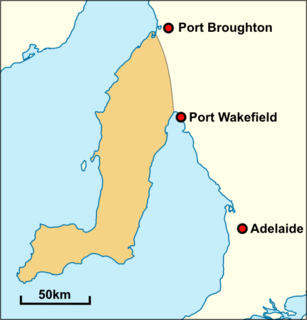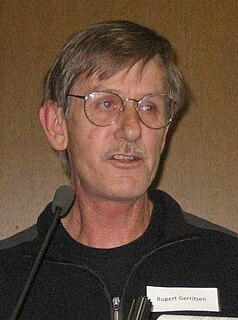Nhanda, also rendered Nanda, Nhanta and Nhandi, is an Australian Aboriginal language from the Midwest region of Western Australia, between Geraldton and the Murchison River, from the coast to about 20 kilometres (12 mi) inland. The language is now spoken, or semi-spoken, by only a few people.
The Djugun are an Aboriginal Australian people of the Kimberley region of Western Australia.

The Narungga people, also spelt Narangga, are a group of Aboriginal Australians whose traditional lands are located throughout Yorke Peninsula, South Australia. Their traditional language, one of the Yura-Thura grouping, is Narungga.

Rupert Gerritsen was an Australian historian and a noted authority on Indigenous Australian prehistory. Coupled with his work on early Australian cartography, he played an influential part in re-charting Australian history prior to its settlement by the British in 1788, and noted evidence of agriculture and settlements on the continent before the arrival of settlers.
Yinikutira, also recorded as the Jinigudira, are the traditional Aboriginal owners of the Country along the Ningaloo Coast in the area of the Exmouth Peninsula in Western Australia now known as the Cape Range National Park. The area is within the Gascoyne region.
The Njakinjaki are an indigenous Noongar people of southern Western Australia, in the Wheatbelt and Great Southern regions.
The Maia were an indigenous Australian tribe of Western Australia.
The Tharrkari, also referred to as the Targari, are an Aboriginal Australian people of the Gascoyne region of Western Australia.
The Tedei, otherwise known as the Thirrily, are an indigenous Australian people of Western Australia. They are a branch of the Yingkarta.
The Yingkarta people, also written Inggarda and Ingarda, are an Aboriginal Australian people of the Gascoyne region of Western Australia.
The Badimaya people are an Aboriginal Australian people from the Mid West region of Western Australia.
The Kalamaia are an indigenous Australian people of the Wheatbelt and Goldfields-Esperance regions of Western Australia.
The Wariangga, also written Warriyangka, are an indigenous Australian people of the Gascoyne region in Western Australia.
The Baiyungu are an indigenous Australian people of the Gascoyne region of Western Australia.
The Nhanda people, also spelt Nanda, Nhunda, Nhanta, and other variants, are an Aboriginal Australian people who live in the mid-west region of Western Australia around the mouth of the Murchison River.
The Mandjindja or Mantjintjarra are an Aboriginal Australian people of Western Australia belonging to the Western Desert cultural bloc.
The Ewamin or Agwamin are an indigenous Australian people of the state of Queensland.

The Nauo people, also spelt Nawu and Nhawu, are an Aboriginal Australian people of the south-western Eyre Peninsula in South Australia. The Nauo language became extinct by the twentieth century, but efforts are being made to revive it.
The Kulumali were an indigenous Australian people of the state of Queensland.
The Marulta were an indigenous Australian people of the state of Queensland, Australia.